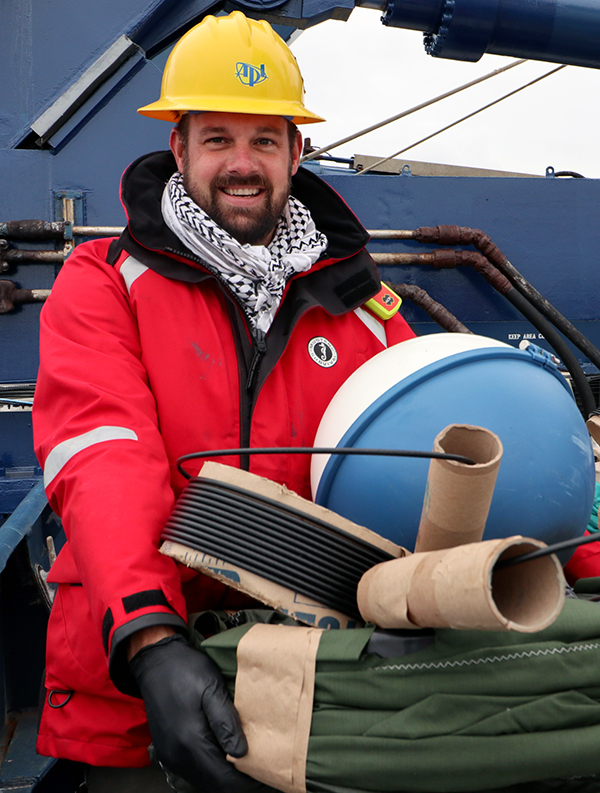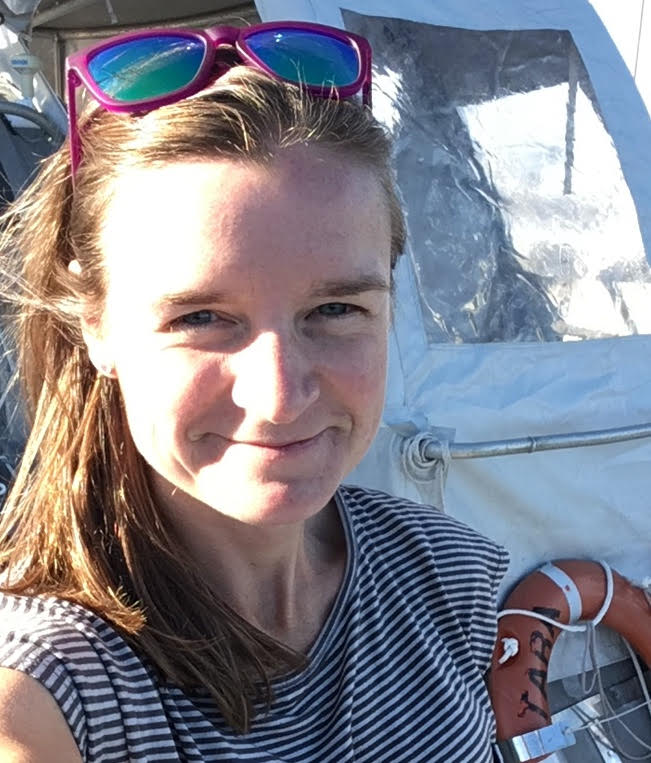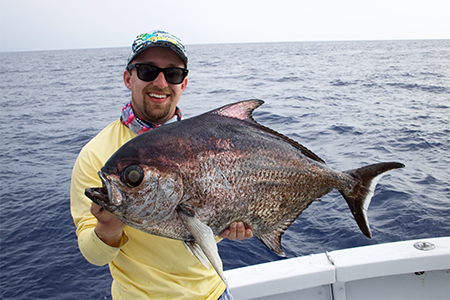The (Sub)mesoscale Group resides in the Air – Sea Interaction & Remote Sensing Department of the Applied Physics Laboratory at the University of Washington in Seattle, WA. We investigate how physical processes modulate life in the ocean. Of primary interest is the influence of mesoscale O(10-100 km) and submesoscale O(1-10km) features, including eddies, meanders, and fronts, on air-sea fluxes, marine ecosystem and ocean mixing.
Current Group Member
Peter Gaube, Principal Oceanographer

My research focuses on the biological response to the horizontal and vertical movement of water masses in the open ocean, and on the fate of the chemicals, nutrients, and particulates that move with them. I am currently investigating the influence of nonlinear mesoscale ocean eddies—large, swirling masses of water that can travel for hundreds of miles—on primary production—the ability of phytoplankton to convert inorganic carbon in the atmosphere and ocean into compounds that form the building blocks of life. In addition, I seek to understand why eddies originating in different regions have different effects on marine ecosystems. To investigate these interactions between the physical and biological marine systems in the open ocean, I use satellite observations, in-situ measurements (Argo floats, gliders, etc.), and the output of numerical simulations.
Ali Chase, WRF Postdoctoral Scholar

I study phytoplankton communities and their distributions on global and ocean basin scales. These “big picture” views are only possible using satellite remote sensing or ecosystem models, and my research supports these efforts by developing algorithms that link phytoplankton communities to environmental and optical parameters using measurements made at sea. We use optical measurements – essentially the color and brightness of the water – to describe the presence of the different phytoplankton groups, which is made possible by the different scattering and absorption properties of different phytoplankton types. Currently, I am a member of the Science and Applications Team for the NASA PACE mission, with the goal of applying our algorithms to identify phytoplankton communities using ocean color measurements to remote sensing data upon the launch of the PACE satellite in 2023.
Carlyn Schmidgall, DOE Graduate Fellow

We will update this soon, check back in!
Previous Group Member
Kyla Drushka, Principal Oceanographer

My work focuses on understanding processes in the upper ocean and at the air-sea interface from in situ and satellite observations, on scales from a single rain storm to (sub)mesoscale to thousands of kilometers. I am particularly interested in understanding how surface forcing (solar, rain, wind) affects near-surface mixing, currents, and stratification. I am currently part of the second Salinity Processes in the Upper Ocean Region Study (SPURS-2), investigating how rainfall affects upper ocean salinity. I am also using in situ observations to characterize how temperature and salinity contribute to (sub)mesoscale density variability, and how we can estimate this from satellite observations of sea surface temperature and ocean color.
Camrin Braun, Assistant Professor at WHOI/MIT

I am primarily interested in the interactions between pelagic (open ocean) fishes and the biology and physics of the ocean. My current research focuses on how oceanography influences behavior of highly migratory fish species, like sharks, tunas and billfish. In the (Sub)mesoscale Group, I am investigating how mesoscale oceanography (eddies, fronts and other forms of ocean motion, like the Gulf Stream) drives movements and behavior of sharks and how different taxa with varying life histories may interact with the marine environment in different ways. To study these interactions, I deploy electronic tags on these study species and couple these observations with satellite, in situ and modeled oceanographic data and simulations to determine how oceanography influences species’ ecology and their interactions with fishing fleets.
Alice “Ali” Della Penna, Lecturer at the University of Auckland, New Zealand

My research aims at understanding how marine organisms (from phytoplankton to top predators) respond to the dynamic and heterogeneous environment of the open ocean. During my Ph.D. I studied how mesoscale features such as eddies and fronts (the oceanic equivalent of atmospheric cyclones and atmospheric fronts) influence top marine predators (seals and penguins) and phytoplankton (the base of all open ocean trophic webs). With my project at APL / Gaubelab I am focusing on the effect of sub- and mesoscale ocean dynamics on intermediate trophic levels (zooplankton and fish). These animals are key stones of marine ecosystems, linking primary production to the upper levels of trophic webs (including humans). Yet, too small to be “tagged” like large fish, marine mammals and seabirds, and invisible to satellites, relatively little is known about their distribution. To find out more about the response of these elusive animals to mesoscale ocean dynamics and other components of marine ecosystems, I combine bio-logging of top predators, in-situ observations from both research voyages and autonomous platforms and satellite data.
Evan Mason, Postdoc Scholar at IMEDEA, Mallorca Spain

My research background is focused on mesoscale features and processes, especially eddies. In my current work at APL in the (Sub)mesoscale Group, I am identifying and tracking intrathermocline eddies in a global high-resolution ocean model. These anticyclonic eddies are characterised by subsurface eddy cores of weakly stratified water, and positive sea surface height signatures at the surface. Relatively little is known about the demographics and properties of intrathermocline eddies in comparison with their standard surface-intensified anticyclonic counterparts. As well as maps of intrathermocline eddy presence, results from the model analysis are enabling us to determine the characteristic surface expressions – in sea surface temperature or chlorophyll, for example. These in turn will help us to determine potential observational criteria for intrathermocline eddy identification.
Bàrbara Barceló-Llull, Postdoc Scholar at IMEDEA, Mallorca Spain

My research has the objective to study and understand mesoscale and submesoscale physical processes and to analyze their impact on the distribution of nutrients. During my Ph.D. I studied the impact of mesoscale vertical velocities on the distribution of nutrients through Lagrangian simulations. We also sampled a mesoscale anticyclonic eddy with CTD, ADCP, and water samples to infer its 3D velocity structure and to analyze its impact on biogeochemical tracers. I inferred the mesoscale vertical velocity field through the application of a generalized omega equation valid for high Rossby flows, and I analyzed the main sources of vertical motion. During my first post-doctoral research at IMEDEA (Spain), I studied the temporal and spatial hydrodynamic variability of an important choke point of the western Mediterranean Sea through the analysis of 8 years of glider data with the main objective to characterize a target region for the fast-sampling phase of the SWOT satellite mission. My current research at the APL-UW has the main goal of analyzing submesoscale features as fronts through the analysis of in situ data (CTD, ADCP, drifters and echo sounder) and remote sensing data.
Martini Arostegui, Postdoc Scholar at WHOI

My primary research interest is the behavior and ecology of fishes in both marine and aquatic ecosystems. The purpose of my current research at UW APL is to develop a mechanistic understanding of the influence of (sub)mesoscale oceanography on the distribution and movement of pelagic fishes. This research will combine satellite telemetry in the Red Sea and fishery-dependent data from Hawaii to explore predator ecology, identify bycatch hotspots, and promote sustainable fisheries. During my PhD at UW SAFS, I studied the ecotypic differentiation of rainbow trout and life history diversity of salmonids in lakes. My other research interests include recreational and commercial fisheries management strategies, trophic ecology of protected species, parasite-host interactions, biological control of human diseases, and stable isotope methodologies.
Suneil Iyer, Postdoc at Oregon State University

My research interests include physical oceanography and air-sea interaction, particularly in the tropical ocean. My master’s work involved using in situ turbulence observations from the second NASA Salinity Processes in the Upper Ocean Regional Study (SPURS-2) to understand how freshwater anomalies in the top meter of the ocean form and mix away following rainfall. I am now expanding upon this work by using a 1-D model to understand how different modes of rainfall in the inter-tropical convergence zone influence the mixed layer salinity structure on different time and depth scales. I’m also studying air-sea interaction in another regime of the tropics: the trade winds. This project, part of the NOAA Atlantic Tradewind Ocean-Atmosphere Mesoscale Interaction Campaign (ATOMIC), uses observations from autonomous platforms that we deployed to investigate how mesoscale and submesoscale ocean fronts create spatial variability in air-sea fluxes and waves.
Emmett Carp Boss” Culhane, Ph.D Student at WHOI/MIT

Emmett is a PhD student in the Marine Predator Group at SAFS and the (Sub)mesoscale Group where he is applying machine learning and other computational tools to marine science. Emmett completed his MSc in Computer Science at Yale in Spring 2020. Prior to attending Yale, Emmett worked as a performer on several DARPA programs under the Information Innovation Office (I2O), where he contributed to research efforts in computer science and counter intelligence. He is currently researching the use of non-linear dimensionality reduction algorithms as a method for taxonomic subtyping of plankton based on in-situ imagery.
Want to learn more about eddies and our research? Check out this short movie.
http://en.wikipedia.org/wiki/Eddy_(fluid_dynamics)
http://www.gfdl.noaa.gov/ocean_mesoscale_eddies
http://www.whoi.edu/main/topic/currents–gyres-eddies
http://www.geol.sc.edu/cbnelson/eddy/eddy.htm
http://oceancolor.gsfc.nasa.gov
An impressive animation of eddies an ocean currents generated by the NASA visualization team.
A short history of the study of mesoscale ocean eddies.

